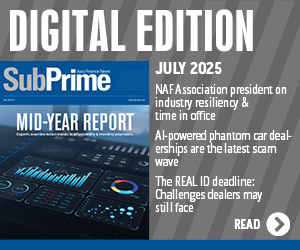Equifax: Lending Continues to Improve, Subprime Borrowers Gaining Share
ATLANTA — Subprime origination growth continued across all lending sectors this past year, according to recent U.S. consumer data from Equifax's March National Consumer Credit Trends Report and CreditForecast.com. And auto finance loan amounts have risen to levels not seen in five years.
In the auto finance segment, subprime borrowers are gaining share in new auto loan originations, the companies explained.
"The evidence of increased lending to subprime consumers demonstrates banks' ongoing efforts to grow lending by providing credit opportunities to more consumers," said Equifax chief economist Amy Crews Cutts. "Year-over-year results show borrowers are taking advantage of the new opportunities and seeking to diversify their financial activity, which is building momentum toward economic improvement."
This trend is especially evident in the auto finance segment, where subprime borrowers now make up over 46 percent of the market, according to data.
Though prime borrowers still make up 83 percent of auto bank originations, they have also lost share over the past two years to subprime borrowers, officials explained.
Moving along, new auto finance loan amounts increased $11.6 billion from 2010 ($164.6 billion) to 2011 ($176.2 billion), hitting the highest originations level since 2007 ($221.1 billion).
And auto bank loans are on the rise, as well. They were up 14 percent year-over-year, rising to $187 billion from $162.1 billion. The companies explained these numbers represented a climb that nearly reached the levels seen pre-recession.
But that’s not all, the number of new auto loan originations increased over 2 percent from 2010 ($17.3 million) to 2011 ($19.6 million).
“The 2011 figure surpasses 2008 totals and is 9 percent lower than the six-year high reached in 2007 of $21.5 million,” officials noted.
"And those delinquency rates for auto finance loans are worse than for auto bank tradelines, both rates have fallen back to pre-recession levels."
And also of note, in 2011, total new auto loan originations hit a six-year high for the month of December, although total originations for the year were at a four-year high.
Highlighting some broad statistics, new credit in 2011 ($782 billion) remained below pre-recession levels, but gained more than 10 percent over 2009 and 2010 levels ($695 and $709 billion, respectively), the companies shared.
Increases in credit limits were also seen this past year. Retail credit card limits increased 6 percent year-over-year, and total bank credit card limits jumped 24 percent during the same peiod.
Lastly, total consumer debt in the U.S. has fallen by double digits.
It currently stands at $11 trillion, a decrease of 11 percent from its peak in Q4 2008 at $12.4 trillion.
Explaining the reasons behind this drop, the companies explained, “The drop is driven by a nearly 12 percent drop in home financing balances, which fell from $9.8 trillion in 2008 to $8.7 trillion in February 2012.
“Non-mortgage and non-student consumer debt balances also fell sharply (22 percent) from the early 2008 peak of $2.05 trillion. After reaching a post-recession low of $1.60 trillion in May 2011, consumer debt balances have risen about 2 percent,” they concluded.


